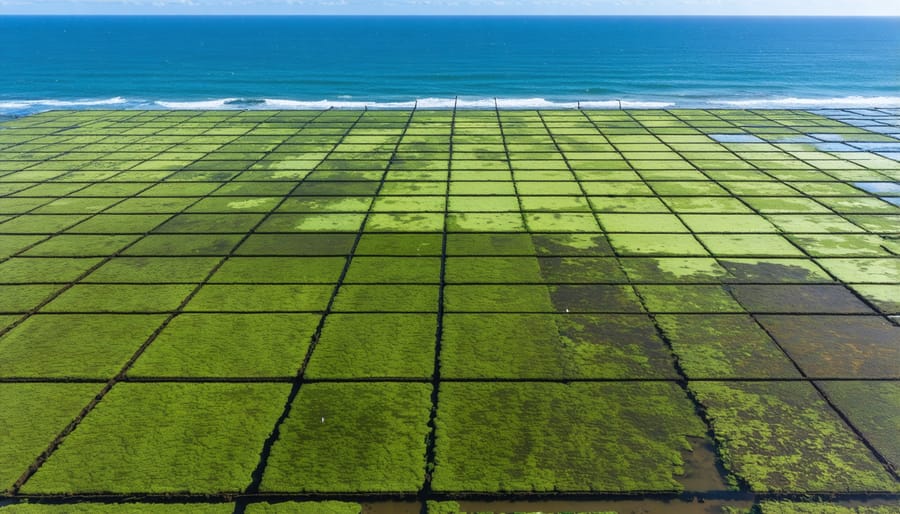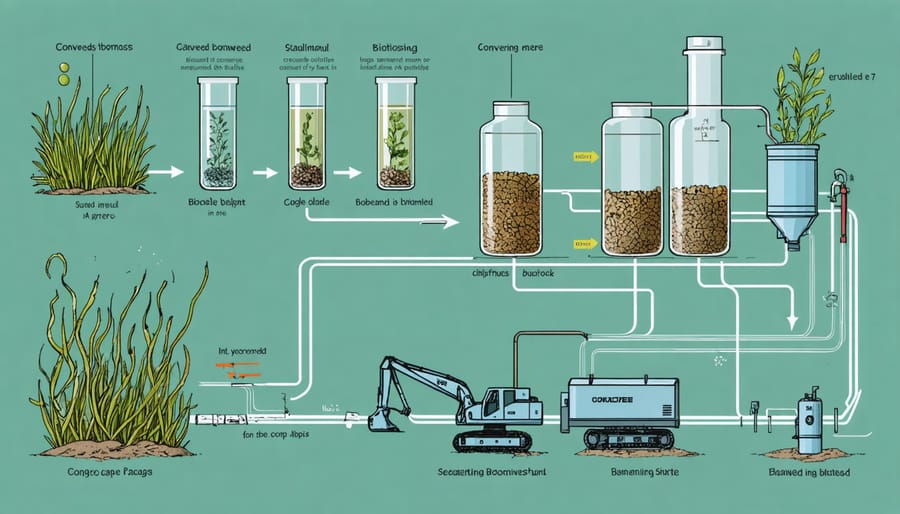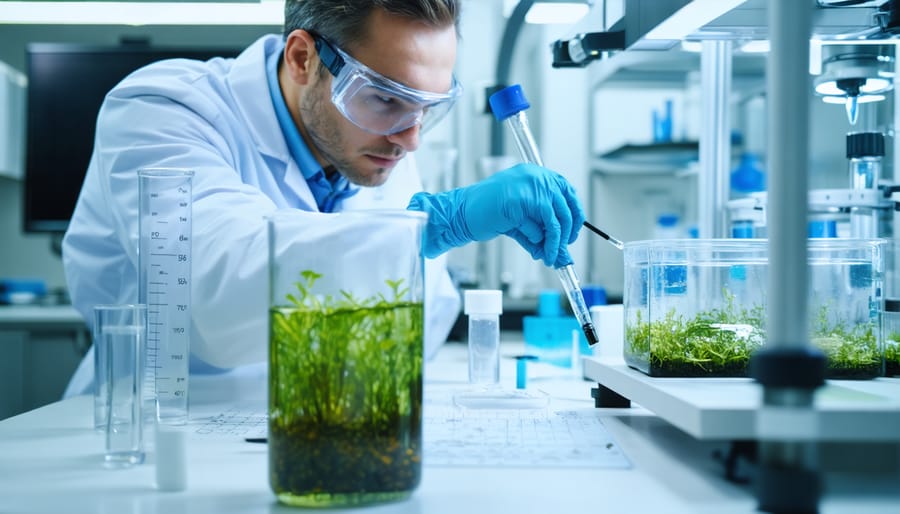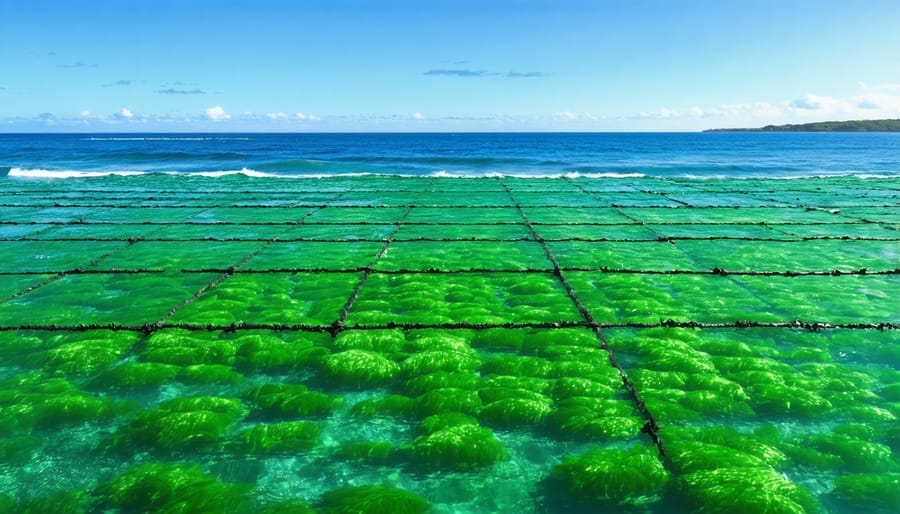In the sun-drenched waters off Australia’s coastline lies a promising solution to our energy challenges: seaweed biofuel. This remarkable renewable resource represents a powerful convergence of marine agriculture and sustainable energy production, offering significant benefits of bioenergy while supporting coastal communities. Unlike traditional biofuels that compete with food crops for land, seaweed cultivation requires no freshwater, fertilizers, or arable land, making it an exceptionally sustainable choice for Australia’s energy future.
Recent breakthroughs in seaweed-to-biofuel conversion have demonstrated yields up to 30 times higher per hectare than land-based biofuels, while simultaneously contributing to ocean health by absorbing excess nutrients and providing marine habitats. Australian researchers are at the forefront of this innovation, developing efficient cultivation methods specifically adapted to our unique coastal conditions and native seaweed species.
As global energy demands intensify and climate challenges mount, seaweed biofuel emerges as a game-changing solution that aligns perfectly with Australia’s maritime resources and renewable energy ambitions. This transformative technology not only promises to revolutionize our energy sector but also creates new opportunities for sustainable economic growth in coastal regions.
Why Seaweed Biofuel Makes Perfect Sense for Australia
Australia’s Coastal Advantage
Australia’s 35,000-kilometer coastline presents an unparalleled opportunity for seaweed cultivation and biofuel production. Our pristine waters and diverse marine ecosystems create ideal growing conditions for various seaweed species, particularly along the southern and eastern coasts where nutrient-rich currents support robust aquatic plant growth.
The combination of year-round sunlight, consistent water temperatures, and protected bays makes Australian waters particularly suitable for large-scale seaweed farming. Our extensive continental shelf provides vast areas of shallow water perfect for seaweed cultivation, while our clean waters ensure high-quality biomass production.
Notable success stories have emerged from pilot projects in Tasmania and South Australia, where commercial-scale seaweed farms are already demonstrating impressive yields. These regions benefit from cool, nutrient-dense waters and strong maritime infrastructure, making them natural hubs for seaweed biofuel development.
Moreover, Australia’s existing aquaculture expertise and marine research capabilities provide a strong foundation for expanding seaweed farming operations. With many coastal communities already equipped with ports and processing facilities, we’re well-positioned to become a global leader in seaweed-based biofuel production.

Environmental Benefits Beyond Energy
Seaweed cultivation for biofuel production offers remarkable environmental benefits that extend far beyond renewable energy generation. These marine forests act as powerful carbon sinks, absorbing CO2 from the atmosphere at rates up to 50 times faster than land-based forests. This natural carbon sequestration capability makes seaweed farming a crucial player in Australia’s sustainable energy future.
The environmental advantages don’t stop there. Seaweed farms create thriving marine ecosystems, providing habitat for countless species and helping to protect biodiversity. They also act as natural filters, removing excess nutrients and pollutants from ocean waters, which helps combat coastal water quality issues and reduces the impact of agricultural runoff.
Furthermore, seaweed cultivation requires no freshwater, fertilisers, or valuable agricultural land, making it an environmentally responsible choice for biofuel production. By establishing seaweed farms along our vast coastline, we’re not just creating sustainable fuel – we’re actively contributing to ocean health and ecosystem restoration while fighting climate change on multiple fronts.
From Ocean to Energy: The Production Process
Cultivation Methods
Along Australia’s expansive coastline, innovative seaweed cultivation methods are taking shape, transforming our waters into productive biofuel farms. Traditional rope-line cultivation remains the backbone of seaweed farming, where specially designed ropes suspended in nutrient-rich waters support the growth of various seaweed species, particularly the fast-growing Asparagopsis and Sargassum varieties.
In recent years, Australian marine scientists have pioneered integrated multi-trophic aquaculture (IMTA) systems, combining seaweed farming with existing fish farms. This symbiotic approach allows seaweed to utilize excess nutrients from fish farming while improving water quality, creating a win-win situation for both crops.
Offshore cultivation platforms are gaining traction, particularly in Southern Australia and Tasmania, where robust ocean currents provide ideal growing conditions. These platforms use advanced mooring systems and submersible structures that can weather rough seas while maximizing sunlight exposure for optimal growth.
Several coastal communities have embraced shore-based tank cultivation, particularly for high-value species used in biofuel production. These controlled environments allow for year-round cultivation and precise monitoring of growth conditions, though at a smaller scale than ocean-based operations.
Emerging technologies include drone-monitored farms and automated harvesting systems, reducing labor costs and improving efficiency. Some innovative farmers are experimenting with vertical cultivation techniques, maximizing yield per square meter of ocean space.
The industry is also exploring artificial intelligence to optimize growing conditions and predict harvest times, while research institutions are developing strain selection programs to identify seaweed varieties best suited for biofuel production in Australian waters. These advanced cultivation methods are setting new standards for sustainable marine farming while supporting Australia’s renewable energy goals.
Conversion Technology
The transformation of seaweed into biofuel involves several sophisticated yet efficient conversion processes. The most common method is anaerobic digestion, where naturally occurring bacteria break down the seaweed in oxygen-free conditions, producing biogas rich in methane. This biogas can then be refined into biomethane, suitable for use in vehicles or feeding into the existing natural gas network.
Another promising technique is fermentation, which converts the sugars in seaweed into bioethanol. Australian researchers have made significant breakthroughs in developing specialized enzymes that can effectively break down the complex carbohydrates found in seaweed species native to our waters, making the process more efficient and economically viable.
Thermochemical conversion represents a third pathway, using high temperatures to transform seaweed into bio-oil through pyrolysis. This process has gained traction in coastal facilities, where the proximity to seaweed farms reduces transportation costs and enhances overall efficiency.
Recent innovations in hydrothermal liquefaction (HTL) technology have been particularly exciting for the Australian context. This process uses high pressure and temperature to convert wet seaweed directly into biocrude oil, eliminating the energy-intensive drying step required in other methods. Several pilot plants along Australia’s coastline are already demonstrating the commercial potential of HTL technology.
The beauty of these conversion technologies lies in their flexibility. Different methods can be selected based on the seaweed species available, local infrastructure, and desired end products. This adaptability makes seaweed biofuel production particularly suitable for Australia’s diverse coastal regions, from the tropical north to the temperate south.

Current Projects and Success Stories

Leading Research Initiatives
Australia’s research landscape in seaweed biofuel development is thriving, with several groundbreaking initiatives leading the charge. The CSIRO, in partnership with various bioenergy innovation hubs, has launched a comprehensive research program focused on optimising seaweed cultivation for biofuel production.
James Cook University’s Marine Research Centre has pioneered breakthrough techniques in Asparagopsis seaweed farming, demonstrating impressive yields while significantly reducing production costs. Their innovative approach combines traditional aquaculture methods with cutting-edge automation technology, setting new benchmarks for commercial viability.
The University of Melbourne’s Algal Research Group has formed a promising collaboration with Indigenous communities in Northern Australia, incorporating traditional knowledge into modern seaweed farming practices. This partnership has already identified several native species with exceptional biofuel potential.
In Western Australia, a consortium of research institutions and industry partners has established the Seaweed Biofuel Innovation Centre, focusing on developing more efficient conversion processes. Their recent breakthrough in enzymatic extraction has reduced processing time by 40% while increasing fuel yield.
These initiatives are complemented by international partnerships, particularly with leading research centres in Japan and Norway, ensuring Australian research remains at the forefront of global seaweed biofuel innovation. The collaborative approach has accelerated development timelines and opened new pathways for commercialisation.
Commercial Applications
Several pioneering companies and research institutions have successfully transitioned seaweed biofuel from laboratory experiments to commercial-scale operations. In Australia, Pacific Bio, based in Townsville, has established a 100-hectare seaweed farm that produces biomethane for local energy needs while creating jobs in coastal communities.
The Seaweed Solutions Initiative, operating along the Great Barrier Reef coast, demonstrates how seaweed cultivation can be integrated with existing aquaculture operations. Their facility produces over 500,000 litres of bioethanol annually while simultaneously improving water quality in reef areas.
In South Australia, the Maritime Biofuel Corporation has partnered with local fishing communities to create a sustainable seaweed harvesting program. Their processing facility in Port Lincoln converts native kelp species into biodiesel, supplying fuel for the local fishing fleet and reducing their carbon footprint by 40%.
Internationally, the Blue Economy CRC project in Tasmania has attracted global attention for its innovative approach to large-scale seaweed farming. Working with European technology partners, they’ve developed floating cultivation systems that produce biofuel while creating marine sanctuaries.
These successful ventures showcase the commercial viability of seaweed-based biofuels while delivering multiple benefits: renewable energy production, coastal employment opportunities, and marine ecosystem enhancement. The growing number of operational facilities demonstrates that seaweed biofuel has moved beyond theoretical potential to become a practical reality in Australia’s renewable energy landscape.
Future Prospects and Industry Growth
Economic Opportunities
The emergence of seaweed biofuel presents a golden opportunity for Australia’s coastal communities and the broader economy. As bioenergy infrastructure investment grows, experts project the creation of thousands of new jobs across the supply chain, from seaweed farming to processing and distribution.
Coastal regions, particularly in Western Australia and Tasmania, stand to benefit significantly from this emerging industry. Local communities can diversify their economic activities beyond traditional fishing and tourism, with seaweed farms creating year-round employment opportunities. Initial estimates suggest that a single commercial-scale seaweed farm can generate up to 100 direct jobs and support an additional 200 indirect positions in related sectors.
The economic ripple effects extend beyond primary production. Research facilities, biotechnology companies, and renewable energy providers are expanding their operations to accommodate this growing sector. Small businesses are emerging to provide specialized equipment and services, while existing maritime industries are adapting their expertise to support seaweed cultivation.
Furthermore, the export potential for Australian seaweed biofuel technology and expertise is substantial. As Asian markets increasingly seek sustainable energy solutions, Australia’s early adoption and innovation in this field position us as potential leaders in the Indo-Pacific region. This creates opportunities for technology licensing, consulting services, and international partnerships, contributing to a robust and sustainable economic future for our coastal communities.
Scaling Challenges and Solutions
While seaweed biofuel shows incredible promise, scaling up production from laboratory success to commercial viability presents several key challenges. The first hurdle is securing enough cultivation space along Australia’s coastline without disrupting marine ecosystems or competing with existing maritime activities. However, innovative solutions like integrated multi-trophic aquaculture systems are showing how seaweed farms can actually benefit local marine life while producing biomass.
Water and nutrient management at scale poses another significant challenge. Forward-thinking companies are addressing this by developing automated monitoring systems and sustainable nutrient recycling methods. These technologies help maintain optimal growing conditions while minimizing environmental impact.
Processing infrastructure represents a substantial investment need, but strategic partnerships between research institutions and industry players are emerging to share costs and expertise. The CSIRO’s collaborative approach with local energy companies demonstrates how public-private partnerships can accelerate development.
Perhaps the most promising solution lies in Australia’s unique position to create seaweed farming hubs along its vast coastline. These hubs would combine cultivation, processing, and distribution facilities, creating economies of scale while supporting regional communities. Several coastal towns are already exploring pilot programs that could serve as blueprints for larger operations.
By addressing these challenges head-on with innovative solutions and collaborative approaches, Australia is well-positioned to become a global leader in seaweed biofuel production.
As Australia charts its course toward a sustainable energy future, seaweed biofuel emerges as a game-changing solution that perfectly aligns with our unique coastal advantages and environmental commitments. The potential of this innovative renewable resource extends far beyond simple energy production – it represents a transformative opportunity to revolutionize our energy landscape while supporting coastal communities and marine ecosystems.
The development of seaweed biofuel in Australia presents a rare win-win scenario where environmental protection meets economic growth. By embracing this technology, we can significantly reduce our carbon footprint while creating thousands of new jobs in coastal regions, from seaweed farming to biorefinery operations. The sustainable nature of seaweed cultivation, requiring no freshwater or agricultural land, positions it as an ideal solution for our drought-prone continent.
Looking ahead, the future of seaweed biofuel in Australia appears remarkably bright. With continued investment in research and development, supportive government policies, and growing industry participation, we stand at the threshold of a new era in renewable energy. The technology’s potential to provide clean, reliable energy while supporting marine biodiversity and coastal economies makes it an essential component of Australia’s renewable energy mix.
As we move forward, seaweed biofuel could help transform Australia from a fossil fuel-dependent nation to a world leader in sustainable energy innovation. This journey represents not just an environmental imperative, but a profound opportunity to shape a cleaner, more sustainable future for generations to come.

